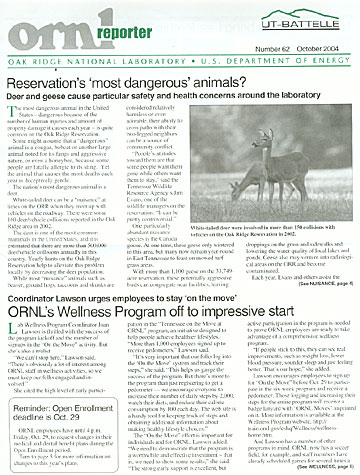 |
| Number 62, October 2004 |
 |
 Reservation’s ‘most dangerous’ animals?
Reservation’s ‘most dangerous’ animals?
 |
| White-tailed deer were involved in more than 150 collisions with vehicles on the Oak Ridge Reservation in 2002. |
Deer and geese cause particular safety and health concerns around the laboratory
The most dangerous animal in the United States – dangerous because of the number of human injuries and amount of property damage it causes each year – is quite common on the Oak Ridge Reservation.
Some might assume that a “dangerous” animal is a cougar, bobcat or another large animal noted for its fangs and aggressive nature, or even a honeybee, because some people are fatally allergic to its sting. Yet the animal that causes the most deaths each year is deceptively gentle.
The nation’s most dangerous animal is a deer.
White-tailed deer can be a “nuisance” at times on the ORR when they meet up with vehicles on the roadway. There were some 160 deer/vehicle collisions reported in the Oak Ridge area in 2002.
The deer is one of the most common mammals in the United States, and it is estimated that there are more than 500,000 deer/vehicle collisions annually in this country. Yearly hunts on the Oak Ridge Reservation help to alleviate this problem locally by decreasing the deer population.
While most “nuisance” animals such as beaver, ground hogs, raccoons and skunks are considered relatively harmless or even adorable, their ability to cross paths with their two-legged neighbors can be a source of community conflict.
“People’s attitudes toward them are that some people want them gone while others want them to stay,” said the Tennessee Wildlife Resource Agency’s Jim Evans, one of the wildlife managers on the reservation. “It can be pretty controversial.”
One particularly abundant nuisance species is the Canada goose. At one time, these geese only wintered in this area, but many now remain year-round in East Tennessee to feast on mowed turf grass areas.
With more than 1,100 geese on the 33,749-acre reservation, these potentially aggressive birds can congregate near facilities, leaving droppings on the grass and sidewalks and lowering the water quality of local lakes and ponds. Geese also may venture into radiological areas on the ORR and become contaminated.
Each year, Evans and others assist the ORNL Environmental Sampling and Data Evaluation group in gathering up the geese during the birds’ flightless period. During this two-day “roundup,” geese are screened for radiological activity. Since 1995, only one roundup has produced a large number of geese that exceeded their radiation threshold. Of the 112 geese screened in 1998, 38 had high levels of radiation.
Members of the roundup team also band and collar the geese as part of a national monitoring program. Banding is instrumental in monitoring goose movements and providing valuable information for management purposes.
One of the most difficult nuisance animals for Evans to handle is the skunk, for obvious reasons. “You can’t just go grab one,” he said. “You can’t just go shoot one.”
However, as long as the skunk doesn’t have to be removed immediately, it can be taken care of. Evans captures the animal with a baited live trap that can be draped with a cover to keep the skunk calm until it can be moved to an area outside humans’ smelling range.
One “nuisance” animal Evans likes, from a wildlife standpoint, is the beaver. Beavers benefit wildlife because they create habitat, attracting species such as muskrats, mink, wood ducks and wading birds.
The problem with beavers is that they need to be in a completely remote area. “Most people are unable to coexist with them,” Evans said.
Beavers often are a novelty to people when they first move into an area, he explained. Problems tend to occur when the population becomes established and the beavers chew up dogwoods and ornamental maples or cause flooding on the property.
ORNL wildlife managers have been controlling nuisance animals since the mid-1980s through deer and turkey hunts. Evans said that the hunts have changed since 9/11, because security concerns require that more areas be restricted to hunters. This makes it more difficult to control the deer population.
“Those deer aren’t going to move if you can’t get in to hunt,” Evans added. “The only effective way to control the population is through culling.”
 |
| Hunts are held each year to help control the wild turkey population on the reservation. |
Evans said that in a lot of cases, wildlife damage is the result of building maintenance and design issues.
“If you put temporary office structures on a site, you’re going to have problems with ground hogs and skunks underneath those buildings,” he said.
Building design and human interaction can be the cause of ORNL staff encounters with nuisance animals, such as the raccoons who strolled down the hallways of Building 1000 in recent years, the groundhogs that dig up contaminated soil and bring it to the surface, or fighting young bucks that once crashed through an office window.
Yet, even with the “nuisance” of dealing with these animals, the reservation provides a unique opportunity to perform sophisticated, well-instrumented environmental experiments.
Evans said that the problem isn’t the high number of nuisance animals on the ORR or the high number of people that now populate the area. The true problem is a result of human and animal interaction.
“If we all walked away from this site, there would be no nuisance animal problem,” he said.—Amy Merrick
[Amy Merrick served as a Communications and Community Outreach intern from the University of Tennessee.]
‘Coordinator Lawson urges employees to stay ‘on the move’
 ORNL’s Wellness Program off to impressive start
ORNL’s Wellness Program off to impressive start
Reminder: Open Enrollment |
|---|
ORNL employees have until 4 p.m. Friday, Oct. 29, to request changes in their medical and dental benefit plans during the Open Enrollment period. |
Lab Wellness Program Coordinator Joan Lawson is thrilled with the success of the program kickoff and the number of signups in the “On the Move” activity. But she’s also a realist.
“We can’t stop here,” Lawson said. “There’s obviously a lot of interest among ORNL staff in wellness activities, so we must keep our folks engaged and involved.”
She cited the high level of early participation in the “Tennessee on the Move at ORNL” program, an initiative designed to help people achieve healthier lifestyles. “More than 1,000 employees signed up to receive pedometers,” Lawson said.
“It’s very important that our folks log into the ‘On the Move’ system and track their steps,” she said. “This helps us gauge the success of the program. But there’s more to the program than just registering to get a pedometer — we encourage everyone to increase their number of daily steps by 2,000, watch their diets, and reduce their calorie consumption by 100 each day. The web site is a handy tool for keeping track of steps and obtaining additional information about making healthy lifestyle choices.”
The “On the Move” effort is important for individuals and for ORNL, Lawson added. “We need to demonstrate that the program is a worthwhile and effective investment – that is, we need to show some results,” she said. “The strong early support is excellent, but active participation in the program is needed to prove ORNL employees are ready to take advantage of a comprehensive wellness program.
“If people stick to this, they can see real improvements, such as weight loss, lower blood pressure, sounder sleep and just feeling better. That’s our hope,” she added.
Lawson encourages employees to sign up for “On the Move” before Oct. 29 to participate in the six-week program and receive a pedometer. Those logging and increasing their steps for the entire program will receive a badge lanyard with “ORNL Moves” imprinted on it. More information is available at the Wellness Program website, http://train.ornl.gov/eshq/Wellness/wellness-home.htm.
 |
| Lawson helped host the wellness kickoff event, attended by hundreds of ORNL staff members. |
And Lawson has a number of other programs in mind. ORNL now has a soccer field, for example, and staff members have already scheduled games for several times a week, during lunch periods and evenings.
“This is an employee-organized activity supported by the Wellness Program,” she explained. “Folks who would like to participate must sign an ‘Assumption of Risk and Release Agreement’ before playing. They should contact Jean-Christophe Bilheux [576-4851].”
Many attendees at the Wellness Program kickoff provided suggestions for other activities, such as yoga, Pilates, aerobics and other exercise classes. Lawson will be tallying and evaluating the suggestions to develop plans for group fitness programs.
She also hopes to prepare a risk-rated needs assessment for staff members. This would supply information on employees’ health risks, such as diabetes, obesity, high cholesterol, hypertension, stress and smoking. This risk-rated assessment will provide ORNL-specific information that will help in developing the laboratory’s wellness program.
Lawson also hopes to arrange for an exercise physiologist to serve as a consultant in the Employee Fitness Center in Bldg. 4500 South. “We’re also looking at the possibility of bringing a nutritionist on board as a consultant to work with employees with diabetes or weight-management concerns.”
Lawson, who worked previously in wellness- and fitness-related activities at Y-12 and TVA, said she has been pleased with the enthusiasm exhibited by ORNL staff. “We have employees who really want to be involved in these activities and take better care of themselves,” she said.
“We want their ideas and suggestions, and we’ll certainly do what we can to help all our folks improve their quality of life.”
 New challenges bring Leadership Team changes
New challenges bring Leadership Team changes
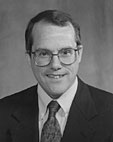 |
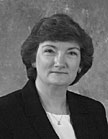 |
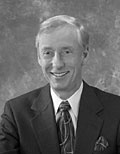 |
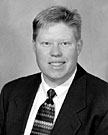
|
|---|---|---|---|
| Roberto | Buchanan | Riedinger | Beierschmitt |
In order to address “a different set of challenges to the laboratory over the next few years,” ORNL Director Jeff Wadsworth has announced a number of Leadership Team changes, which become effective Nov. 1.
Jim Roberto will become deputy director for Science and Technology. Michelle Buchanan, director of the Chemical Sciences Division, will succeed Roberto as associate laboratory director for Physical Sciences.
 |
 |
|---|---|
| Downer | Stair |
Current Deputy Director Lee Riedinger will assume the new position of associate laboratory director for University Partnerships, reflecting, as Wadsworth described, a “radical change in our recruiting strategy and our engagement with the world’s premier universities and research laboratories at a level well beyond our current efforts.”
The lab’s nuclear operations are being gathered under a new organization to be led by current Environment, Safety, Health and Quality Director Kelly Beierschmitt. In his new role as director for Nuclear Operations, he will have responsibility for the Non-reactor Nuclear Facilities Division and the Nuclear Capabilities and Facilities Consolidation Project. He also will provide senior management staff support and oversight concerning operational matters associated with the High Flux Isotope Reactor. Karen Downer, ESH&Q deputy director, will succeed Beierschmitt as ESH&Q director.
Wadsworth announced that David Price, executive director for HFIR and the Research Reactors Division responsible for HFIR operations, will report directly to him. Price will retain line accountability for HFIR and is expected to work closely with Beierschmitt in his new role for support on operational matters.
With an eye toward an emphasis on recruitment, the laboratory’s human resources strategy is being redesigned to include a new department structure with different roles and responsibilities. Darryl Boykins is stepping down as director of Human Resources and will undertake assignments for Wadsworth in support of the laboratory. General Counsel Steve Porter will serve as interim HR director until a new director is named.
Wadsworth also announced the formal expansion of the job content of ORNL’s director of Communications position “to reflect more accurately the complexity of the assignment.” Billy Stair’s new title is director of Communications and External Relations, which recognizes the breadth and impact of the position.
The changes are outlined at http://www.ornl.gov/info/org_charts/ornl_org.pdf.
 Beans, not borscht, for visitors
Beans, not borscht, for visitors
Under a special export license granted by the U.S. government, four scientists and an interpreter from the Institute of Experimental Physics, Russian Federal Nuclear Center, spent a month at ORNL learning to build Nuclear Materials Identification System processor circuit boards. NMIS is a measurement method developed by ORNL’s John Mihalczo (Engineering Science and Technology) to identify nuclear materials. Using a small radioactive test source, high-speed data acquisition and statistical analysis, the amount and geometry of nuclear material inside a closed container can be determined. This is especially useful in verifying the inventory of assets such as weapons-grade nuclear materials.
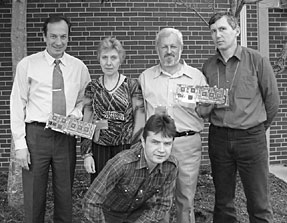 |
|---|
Russian team members with the NMIS processor boards are, from left, Alexy Kholostov, Nataliya Vorontsova, Alexander Obernikhin and Valeriy Svirdov. Oleg Makarov is kneeling. |
Wes Wysor of Engineering Science and Technology served as primary sponsor and liaison for the group. Peggy DePorter and Lucy Watkins of Craft Resources and John Cox of Fabrication initiated an intense hands-on training regiment for the Russian team. The first few days were spent watching and practicing micro-fabrication under the microscope with technical expertise provided by ORNL staff. As they neared the end of the “crash course,” it became clear which members of the Russian team belonged at the microscope and which were best suited for testing and support.
ORNL hosts of the group also organized Friday home-cooked lunches featuring East Tennessee specialties such as cornbread and beans, potato salad and banana pudding, Fabrication Division Director Claude Robison reports that the lunches were a big hit – with the smiling and appreciative Russians asking for second helpings and leftovers “to go.”
Robinson added that the visit was a rewarding experience for everyone involved. The Russians completed their contractual obligations and are able to implement the ORNL-developed technology back at home. They have a new tool to help inventory and verify their stockpile of weapons-grade nuclear materials. Lab staff members were treated to a unique glimpse into the lives of Russian citizens. And during the daily interactions, real friendships were established between members of the ORNL and Russian teams. A definite “win-win” for all.
 Happiness is a warm linac
Happiness is a warm linac
With the recent “warm commissioning” of its linear accelerator, the Spallation Neutron Source has passed a crucial test and milestone on its way to completion.
The SNS’s linear accelerator, or linac, is composed of two sections: the “warm,” or room temperature section, and a superconducting section that operates at temperatures hundreds of degrees below zero. Los Alamos National Laboratory, part of the team of six DOE national labs collaborating on the SNS construction project, is responsible for the warm linac.
“The successful commissioning of the warm linac is another step toward the 2006 completion of the SNS and again demonstrates the success of the collaboration of national labs in keeping the project on time, on budget and on scope,” said SNS Director Thom Mason.
The warm section will provide 20 percent of the total acceleration of the 1,000-foot-long linac. The linac’s superconducting section, provided by the Thomas Jefferson National Accelerator Facility, will provide 80 percent of linac acceleration. Testing also has begun of components of the superconducting portion, which consists of niobium cavities chilled by liquid helium to minus 456 degrees Fahrenheit.
 Floyd Culler passes away
Floyd Culler passes away
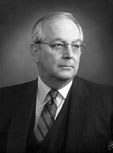 |
|
|
Floyd Culler, ORNL deputy director from 1970 to 1977, died Sept. 29 in San Juan Capistrano, Calif.
Culler, president of the Electric Power Research Institute from 1978 to 1988, was a recipient of DOE’s Ernest O. Lawrence Memorial Award, a member of the National Academy of Engineering and a fellow of the American Institute of Chemists, American Institute of Chemical Engineers and American Association for the Advancement of Science.
After coming to Oak Ridge in 1943 from Johns Hopkins University, Culler worked at the Y-12 Plant until accepting a post at ORNL in 1947 as design engineer for nuclear-fuel recycling plants. He became section chief and later director of the Chemical Technology Division. Culler managed the lab’s development of solvent extraction and other processes for recovery of uranium, plutonium, and fission products from spent nuclear fuels. His team established nuclear-fuel reprocessing techniques used worldwide. He served as lab associate director for nuclear technology in 1964 before being named laboratory deputy director. Culler also was acting laboratory director in 1973-74 after the retirement of Alvin Weinberg.
 Main Street: The place to be
Main Street: The place to be
ORNL’s “Main Street” has been a busy thoroughfare lately. Autumn events have included the International Festival, “Tennessee on the Move at ORNL” kickoff, Volunteer Fair and Benefits/Wellness Fair. A string quartet sponsored by the Oak Ridge Civic Music Association gave a lunchtime performance on a recent Friday, and the conveniently located Lab Branch of the ORNL Federal Credit Union celebrated its first year onsite.
Credit Union branch manager Leigha Stewart and CU staff congratulate the following lucky members, who won door prizes given away in honor of the branch’s anniversary: Charlie Sweat, Craft Resources (DVD player); Cheri Cross, Property Management (DVD player); and Andy Christopher, Craft Resources (home theater system).
| —Reported by Cindy Lundy and Bill Cabage |
 New Staff Members
New Staff Members
ORNL continues to grow. This feature lists new employees at the laboratory. Welcome to all.
Shelia McClure, Biological & Environmental Sciences Directorate
Michael Estep, Business & Information Services Directorate
Gary Lynn and Sandra Solands, Chemical Sciences
Ryan Bennink, Computer Science & Mathematics
David Singh, Condensed Matter Sciences
William Needham Jr., Facilities Management
Edward Harrington and Antonia Rucci, National Security Directorate
Kimberly Daugherty, Nuclear Science & Technology
Katherin Goluoglu, Operational Safety Services
William Hix, Physics
Melvin Booker and Kevin Corbett, Quality Services
William Krapf and Shannon Watters, SNS Accelerator Systems
Mark Phillips, SNS Experimental Facilities
By Technology Review magazine
 Delmau named one of world’s top young innovators
Delmau named one of world’s top young innovators
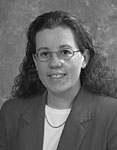 |
|---|
ORNL’s Lætitia
Delmau has been named by Technology Review magazine as one of the world’s top young innovators. Delmau joins the “TR100” group of 100 selected by the Massachusetts Institute of Technology’s science publication.
Delmau, a researcher in the Chemical Sciences Division, specializes in studies of the physical properties of ligands and separation science with an emphasis on thermodynamics, radiochemistry and physical chemistry.
“Lætitia’s selection by Technology Review is a timely recognition of her remarkable record of scientific achievement and, coming at this early point in her career, also signifies her tremendous potential in the field of chemical sciences,” said ORNL Director Jeff Wadsworth.
Her work has centered on technologies for the treatment of nuclear wastes in Europe, Japan and the United States. Delmau, the first author on two patents in France resulting from her work with the French Atomic Energy Commission, came to the United States first as a student in 1992 at ORNL, where she continued her work with nuclear waste treatment technologies during one fall and two summer terms.
Delmau joined ORNL’s research staff in 2000 following a postdoctoral research appointment. She was instrumental in the development of a selected process for removing radioactive cesium from nuclear waste material. She has more than 40 open-literature publications, including 15 journal articles and a book chapter. Overall, she has three patents.
This year’s TR 100 group was selected from a field of nearly 650 candidates under the age of 35.
Delmau and other TR 100 winners joined top innovators and peers from a variety of backgrounds, disciplines and institutions at this fall’s Emerging Technologies conference at MIT in Cambridge.
A native of Marseilles, France, Delmau received her engineering degree from the Ecole Nationale Supériuere de Physique et Chimie de Paris, France, and master’s degree in radiochemistry from the University of Paris VI. She received her doctorate in physical chemistry from the University Louis Pasteur of Strasbourg, France.
Delmau, who resides in Oak Ridge, counts playing the clarinet, target shooting, kayaking and scuba diving among her outside interests.
New medical plan added for 2005
 Benefits Open Enrollment continues through Oct. 29
Benefits Open Enrollment continues through Oct. 29
ORNL employees will have until 4 p.m.
Oct. 29 to request changes in their medical and dental benefit plans during the Open Enrollment period.
Benefit Plans officials have announced the addition of a new medical plan, which will be administered by CIGNA. The new plan, a Point of Service (POS) plan, features basically the same in-network and out-of-network plan design as the current Option 2 POS plan.
The main changes are the addition of expanded network features currently available in the Open Access plan, including the Tennessee Seamless network and access to the CIGNA national network system (including guest privileges), and full online access to myCIGNA.com to view health-related information, benefit coverage information and claims status.
The new plan replaces the Option 2 (Healthsource) plan that CIGNA will discontinue in January 2005.
The Matria PHAP/Disease Management Program will be available to all participants in the new POS plan as well as the Open Access plan.
UT-Battelle also is offering a second dental plan for 2005. Employees may choose to remain with the current MetLife plan or enroll in a new plan from Delta Dental. The Delta Dental Premier plan offers the same premium for salaried employees and a similar reimbursement level of benefits as the MetLife plan. Both plans offer an increased benefit for using a participating dentist and have a national network of participating dentists.
Detailed information on plans and premiums is available at the Open Enrollment website, http://home.ornl.gov/directorates/human_resources/openenrollment/.
If you have questions, contact ORNL Employee Benefits at ornlbenefits@ornl.gov or 574-7474 (toll free 866-576-7766); or contact OneCall at 574-1500.
 2003 Benefit Plans Summary Annual Report
2003 Benefit Plans Summary Annual Report
Plan participants and beneficiaries:
[The 2003 benefits plans report has been prepared in accordance with instruction from the U.S. Department of Labor and is required by the Employee Retirement Income Security Act of 1974.]
This report summarizes the annual reports of the benefit plans provided by the sponsoring employers, BWXT Y -12, L.L.C. (Employer Identification Number: 54-1987297) and UT-Battelle, L.L.C. (Employer Identification Number: 62-1788235.) The report is written in language specified under regulations prepared by the Department of Labor.
The sponsoring employers offered benefit plans under three structures during calendar year 2003. The qualified retirement and savings plans are multiple employer plans, with both employers participating and under an administrative services agreement, BWXT Y -12, L.L.C. serving as the plan sponsor and plan administrator. Five health and welfare plans (The Group Health Plan, The Dental Assistance Plan, The Group Life Plan, The Special Accident Plan, and the Travel Accident Plan) were provided under a Multiple Employer Welfare Agreement, with an administrative services agreement that has BWXT Y-12, L.L.C. serving as the plan administrator. The individual companies sponsored separate health and welfare plans for Long Term Disability, Employee Assistance, Education Assistance, Cafeteria Plan and a Severance Plan for Salaried Employees.
Complete annual reports for all the offered plans have been filed with the Internal Revenue Service as required by the Employee Retirement Income Security Act of 1974.
Summary Annual Report
Multiple Employer Plans
Retirement Program Plan for Employees of Certain Employers of the U.S. Department of Energy Facilities at Oak Ridge, Tenn. (The Retirement Plan)
The following is a summary of the annual report for the Retirement Plan for 2003.
Basic Financial Statement
Benefits under the plan are provided by group annuity contracts and separate trust investment accounts. Plan expenses were $160,801,000. These expenses include $146,385,000 paid to participants and beneficiaries and $14,416,000 in administrative expenses. A total of 22,925 persons were participants in or beneficiaries of the plan at the end of the plan year, although not all of these persons had yet earned the right to receive benefits.
The value of plan assets after subtracting liabilities of the plan, were $2,691,958,134 as of December 31, 2003, compared to $2,357,901,182 as of January 1, 2003. During the year, the plan experienced an increase of $332,193,000. The plan had a gain of $492,994,000, including earnings and losses from investments. During the plan year, the plan transferred $1,864,000 to other pension plans.
The plan has contracts with the Metropolitan Life Insurance Company and the Prudential Insurance Company of America that guarantee the liabilities of all participants retiring before July 1998. The assets of the plan are invested in Separate Accounts of the insurance companies or in separate trust accounts in accordance with the contract terms.
Minimum Funding Standards
An actuary’s statement shows that enough money was contributed to the plan to keep it funded in accordance with the minimum funding standards.
Your Right to Additional Information
Participants have the right to receive a copy of the full annual report, or any part of it, upon request. The items listed below are included in that report.
- an accountant’s report
- assets held for investment
- insurance information
- actuarial information regarding the funding of the plan
- transactions in excess of five percent of plan assets
Savings Program for Employees of Certain Employers at the U.S. Department of Energy Facilities at Oak Ridge, Tenn. (The Savings Plan)
This is a summary of the annual report of the Savings Plan for 2003, including basic financial statements.
Benefits under the Savings Plan are provided by a trust fund. Plan expenses were $51,722,000; including benefits paid to participants of $50,906,000 and administrative expenses of $816,000. A total of 10,641 were participants in or beneficiaries of the Plan at the end of the plan year, although not all these persons had yet earned the right to receive company matching contributions.
The value of plan assets as of December 31, 2003 , after subtracting liabilities of the plan, was $1,154,577,000 compared to $989,337,000 as of January 1, 2003. During the year, the plan experienced an increase in net assets of $165,240,000. This increase includes the unrealized appreciation or depreciation in the value of the plan assets; that is the difference between the value of plan assets at the end of the year and the value of assets at the beginning of the year or the cost of assets acquired during the year. The plan had total income of $216,962,000; including employer contributions of $ 17,875,000; employee contributions of $48,606,000; realized and unrealized gains and losses of $118,893,000 and other earnings from investments of $31,588,000.
Your Right to Additional Information
Participants have the right to receive a copy of the full annual report, or any part of it, upon request. The items listed below are included in that report.
- an accountant’s report
- assets held for investment
- transactions in excess of five percent of plan assets
Multiple Employer Welfare Agreement (MEWA)
Under this agreement, the participating employers jointly offer health and welfare plans including health, life, special accident, travel accident, dental, and long term care. Insurance policies for the plans included in the MEWA are held in trust by the Oak Ridge Insurance Benefit Trust. This is a summary of the plans included in the MEWA.
Group Welfare Benefit Plan
The health plan operates under contracts between the participating employers and various health care providers which include true insurance contracts (premiums paid for services provided) and other insurance arrangements that require that the participating companies will supply funds for the payment of all claims due under the terms of the contracts, up to a specified maximum determined each plan year. For the plan year 2003, the maximum (CIGNA Option 1 Plan) was $69,463,481. The companies share the cost of the group health plans with the participants by charging premiums to the employees. For the plan year ended December 31, 2003, the total premiums paid were $25,789,037, the total claims paid were $140,396,068 and administrative expenses were $4,070,350. Employees provided $42,295,750 of funds to pay these premiums, claims and expenses and $127,959,705 was provided by the employers.
The financial statements of the Group Health Plan also reflect the postretirement benefit obligations of the employers. This obligation represents the present value of future benefits to be paid to covered participants. The benefit obligation is determined by the plan actuaries. As of December 31, 2003, the benefit obligation was $963,725,672 as compared to the benefit obligation at January 1, 2003, of $1,122,653,670. The decrease in benefit obligation of ($158,927,998) is attributed to a change in benefit obligation of ($175,186,439) and an increase in claims incurred but not yet reported of $16,258,441.
Plans Maintained Separately by the Sponsoring Companies
BWXT Y-12, L.L.C.
In addition to the multiple employer plans above, BWXT Y -12, L.L.C. sponsors the following Plans: Special Medical Plans for LMUS Retirees, Long Term Disability Plan, Cafeteria Plan, Employee Assistance Plan, Educational Assistance Plan, Prescription Drug Plan (financial data included in The Group Health Plan) and The Severance Plan for Salaried Employees. BWXT Y-12, L.L.C. has committed itself to pay certain claims incurred under the terms of these plans.
Annual reports are filed for each of these plans.
UT-Battelle, L.L.C.
In addition to the multiple employer plans above, UT -Battelle, L.L.C. sponsors the following Plans: Prescription Drug Plan (financial information is included in The Group Health Plan), Cafeteria Plan, Long Term Disability Plan, Employee Assistance Plan, Educational Assistance Plan and The Severance Plan for Salaried Employees. UT-Battelle, L.L.C. has committed itself to pay certain claims incurred under the terms of these plans.
Annual reports are filed for each of these plans.
For more detailed information
To obtain a copy of the full or partial annual reports for the insurance plans, retirement program plan or savings program, write to Plans Administrator: BWXT Y-12, L.L.C., 104 Union Valley Road, Oak Ridge, TN 37831-6497. Copying costs are 25 cents per individual page; $4 for the complete insurance plans; $5 for each savings plan annual report; and $10 for the entire retirement program plan annual report.
With regard specifically to the retirement program plan and savings plans, participants have the right to receive from the plan administrator, on request and at no charge, a statement of the assets and liabilities of the plan and accompanying notes, a statement of income and expenses of the plan and accompanying notes, or both.
For each participant requesting a copy of the full annual report, these two statements and accompanying notes will be included as part of that report. The copying cost previously mentioned does not include a charge for duplicating these portions of the report because they are furnished without charge. Participants also have the legally protected right to examine the insurance, savings or retirement program plan annual reports at the main office, located at 104 Union Valley Drive, Rm. 126, Oak Ridge, Tenn., and at the U.S. Department of Labor in Washington, D.C.
Participants also may obtain copies from the U.S. Department of Labor upon payment of copying costs. Requests to the Department of Labor should be addressed to: Public Disclosure Room, N4677, Pension and Welfare Benefit Programs, Frances Perkins Department of Labor Building, 200 Constitution Avenue, N.W., Washington, DC 20216
 Vanderbilt joins ORNL ‘core universities’ group
Vanderbilt joins ORNL ‘core universities’ group
ORNL has announced that Vanderbilt
University has joined the laboratory’s “core universities.” The core universities—which now number seven—assume a scientific leadership role in working with the laboratory to help shape the research agenda for more than one billion dollars in science and technology programs.
ORNL Director Jeff Wadsworth said Vanderbilt’s membership in the core universities honors an invitation made four years ago when UT-Battelle became the lab’s managing contractor.
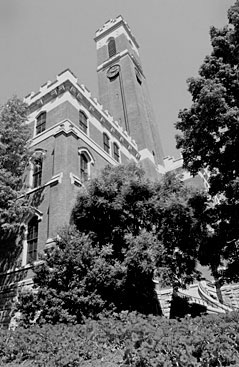
|
|---|
|
Vanderbilt University’s Kirkland Halle |
“Vanderbilt is an outstanding addition to our core universities,” Wadsworth said. “The school’s superb capabilities, particularly in the area of medical research, are ideally suited to ORNL’s emerging programs in genomics and the biosciences.”
Vanderbilt joins Duke, Florida State, Georgia Tech, North Carolina State, the University of Virginia and Virginia Tech as part of ORNL’s core university arrangement with Oak Ridge Associated Universities. Along with the University of Tennessee, ORNL engages with ORAU and the core universities in a variety of ways. Joint faculty appointments, for example, enable a university faculty member to conduct research at the laboratory for extended amounts of time, with costs shared by the two institutions. The core universities also support the laboratory in the development of major new science initiatives and provide leadership in expanding university interaction with ORNL across the broader academic research community.
Wadsworth said he does not anticipate further additions to the core university group “in the foreseeable future.”
Vanderbilt Chancellor Gordon Gee said, “We are delighted to be a part of the most exciting and important science initiative in the country and a significant engine for economic activity in Tennessee. This relationship will add a whole new dimension to our research and teaching activities. Along with the biosciences, Vanderbilt’s work in the basic sciences, engineering and technology will benefit immensely.”
Vanderbilt has a long record of partnership with ORNL, most notably in the physical sciences. Vanderbilt was the driving force with UT in the establishment in the 1980’s of ORNL’s Joint Institute for Heavy Ion Research. The institute is serving as the model for three additional joint institutes currently being established at the laboratory, which is midway through a $1.7 billion construction program that includes a new Center for Computational Sciences, the Spallation Neutron Source, the center for Nanophase Materials Science, a new facility for advanced microscopy and a new laboratory for ORNL’s renowned mutant mouse colony.
The laboratory also has a close working relationship with Oak Ridge Associated Universities, a consortium of 91 major research institutions.
Vanderbilt University is a private research university of approximately 6,300 undergraduates and 4,800 graduate and professional students. Founded in 1873, the university comprises 10 schools, a public policy center, a distinguished medical center and the Freedom Forum First Amendment Center. Vanderbilt offers undergraduate programs in the liberal arts and sciences, engineering, music, education and human development, and a full range of graduate and professional degrees.
 ORNL People
ORNL People
 |
 |
|---|---|
| Hsueh | |
The Operational Safety Systems Division’s Joe Weaver, serving in the Army 352nd Civil Affairs Command, became the first soldier from this area to receive a Bronze Star for service in Operation Iraqi Freedom. He was assigned to Kuwait and spent much time in Iraqi combat zones, coordinating civil affairs tasks, for which he has been cited. The medal recommendation said “LTC Weaver consistently applied common sense to problem solving and treated everyone with fairness and respect. He was consistently sought after for advice from his peers and superiors in both personnel and military issues. His calm demeanor and high sense of professionalism set the tone for his subordinates and established the foundation for a high-performance working environment, well known and respected throughout [Army] commands and staff personnel.”
The Metals & Ceramics Division’s Chun-Hway Hsueh was elected a fellow of the World Innovation Foundation, an international, multidisciplinary consultative research group that advises nations and their governments behind the scenes. There are some 2,000 WIF members and fellows throughout the world, including 57 Nobel Laureates. For each governmental or international topic, about 30 members and fellows will undertake consultations in concert but separately over a period of eight weeks to provide input. Hsueh was elected a fellow of the American Ceramic Society earlier this year.
Peter Blau, Metals and Ceramics Division, was the subject of a feature article in the September issue of Tribology & Lubrication Technology magazine. The article comprises one in a series of interviews with experts in the field of friction, lubrication, and wear. It discusses Blau’s early career in materials science when he studied lunar soil samples for NASA during the Apollo Program and describes how his interest in non-traditional areas of materials research eventually led him into the field of tribophysics. His role at ORNL includes leading the Machining, Inspection, and Tribology User Center in the High Temperature Materials Laboratory.
Michael T. Rochford has joined ORNL as director of the Office of Counterintelligence. Rochford comes to Oak Ridge from Washington, D.C., where he most recently served as chief of the espionage section in the FBI’s Counterintelligence Division. He has more than 28 years of service with the FBI, including 24 years in espionage and foreign counterintelligence investigations. OCI’s Chris Marsalis had served as acting director.
 Generous employees lift United Way campaign to record
Generous employees lift United Way campaign to record
This year’s United Way campaign has raised nearly $825,000 for East Tennessee agencies, far exceeding the goal and setting a record with the largest amount ever for an ORNL drive.
The laboratory’s total of $824,468 — the largest for any campaign in the region — includes employee contributions of more than three quarters of a million dollars, plus a corporate donation of $73,630 by managing contractor UT-Battelle. The figure represents an increase over last year’s donations, even though the number of laboratory staff members has decreased slightly.
“We know that our employees are among the most generous people anywhere,” said laboratory campaign chairman Scott Branham. “During a year when they have been involved in dozens of volunteer service projects for worthy causes in our area, they also have come forward with the financial resources to make this a record year for United Way giving.
“Not only did we surpass last year’s total of $800,000, but we exceeded our campaign goal by more than $70,000. I’m extremely proud of and grateful to our staff,” Branham said.
Special activities – including book fairs and the popular International Festival – added nearly $12,000 to this year’s campaign coffers.
The ORNL donations include the following approximate amounts to counties in the region: Anderson, $263,000; Blount, $19,000; Campbell, $9,000; Knox, $335,000; Loudon, $40,000; McMinn, $1,900; Monroe, $4,000; Morgan, $28,000; Roane, $106,000; Sevier, $3,000; Union, $4,000.
 Volunteer activities going strong as holidays near
Volunteer activities going strong as holidays near
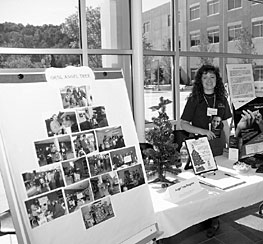 |
|---|
| Sheri Coffey and the Angel Tree committee are looking for elves.
|
Some 400 ORNL employees attended the recent Team UT-Battelle Volunteer Fair, which featured 40 exhibitors who explained volunteer activities and community service opportunities.
| ~ |
|---|
Team UT-Battelle Coordinator Bill Pardue said he hopes that the Main Street event “further stimulated the already strong volunteer enthusiasm among lab employees.”
In addition to individual employee involvement in worthwhile causes of the individual’s choice over the past four years, Team UT-Battelle has sponsored group events through which individuals have contributed more than 14,000 hours and raised more than $200,000.
| ~ |
|---|
Among the exhibitors at the Volunteer Fair was lab employee Sheri Coffey (shown at right), who is coordinating this year’s ORNL Angel Tree Program. Although Christmas is a couple of months away, Coffey and her committee are planning their event now and looking for additional volunteers.
“For the past six years, employees at ORNL have responded to the needs of children in our surrounding communities by providing them with ‘wish list’ gifts of clothing and toys,” Coffey said. “Last year, employees generously provided their time and gifts for 200 children listed on the ORNL Angel Tree Website.”
If you are interested in working with the Angel Tree Committee or helping with the collection days in December, contact Coffey at 574-4168 or coffeysl@ornl.gov.
| ~ |
|---|
Cathy Cheverton, Team UT-Battelle coordinator for the Komen Race for the Cure, expressed her thanks to everyone who registered for the 2004 race to benefit breast cancer awareness, research and treatment.
ORNL had a total of 294 team members for 2004, which beat last year’s team size by 100 and won the UT-Battelle group the “largest corporate team” award. The total dollar amount presented to the Knoxville Komen Foundation by Team UT-Battelle was more than $7,000.
Cindy Lundy, editor, ORNL, 865/574-1642 (lundycr@ornl.gov)
Deborah Barnes, associate editor, 865/576-0470 (barnesds@ornl.gov)
ORNL office: P.O. Box 2008, Oak Ridge, TN 37831-6146, Building 4500-S, Room F-60, MS 6146
News Deadlines
DOE inspector general hotline: 1-800-541-1625
[an error occurred while processing this directive] [an error occurred while processing this directive]
